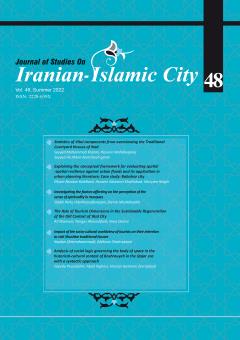Knowing the Dimensions of Tourism in the Sustainable Regeneration of the Old Context of Yazd City
Subject Areas : Historical context of historical cities of Iran
Ali Shamaei
1
,
Narges Ahmadifard
2
![]() ,
Sima Daemi
3
,
Sima Daemi
3
1 - Associate professor of geography and Urban planning, Kharazmi University, Tehran, Iran
2 - lecturer of Department of Urban Engineering, Science and Reasearch Branch, Islamic Azad University, Tehran, Iran
3 - Phd in Geography and Urban Planning, Kharazmi University, Tehran. Iran
Keywords: Tourism, Sustainable Urban Regeneration, Old Context, Yazd City,
Abstract :
Regeneration for updating the old textures In addition to meeting the needs of the people and daily life has a meaningful reference to the identity of the old textures, which can be achieved only in the group of attention to the dimensions of tourism in all fields. The dimensions of sustainable tourism from the economic, social, physical and environmental aspects are consistent with the dimensions and indicators of regeneration. For this purpose, the intended research has used these four approaches to investigate the dimensions of urban tourism in recreating the historical context of the studied city. Our type of research is practical and its method is exploratory-analytical. The statistical population of the research is citizens living in the old context of Yazd city with a sample size of 274 people using Cochran's formula and 30 urban specialists and experts. The results of the research showed that the development of tourism has played the biggest role in the indicators of the physical and economic dimensions. Also, urban tourism has played a role in creating cultural facilities, entertainment and sports centers, increasing social relations, cultural exchanges, strengthening the city's cultural identity, developing service activities, and preventing economic stagnation. Also, the results obtained from the SOAR analysis showed that the most important impact of tourism is the participation of the residents in tourism and urban regeneration programs and plans and the creation of recreational places to attract and retain more tourists.
الهی منش، محمدحسن و ماه خاتون سیدباقر حسینی نژاد و محسن یاسمی (1397) نقش اقتصادی گردشگری در توسعه پایدار شهری (مطالعه موردی: شهر بندر عباس).
فصلنامه علوم اجتماعی، دوره 12، شماره 42، صص 33- 42.
بابایی فرد، اسداله و امین حیدریان (1395)گردشگری فرهنگی و توسعه پایدار شهری با تأکید بر بازآفرینی بافت¬های فرسوده تاریخی.
همایش ملی بافت های فرسوده و تاریخی شهری، دانشگاه کاشان، دوره 1 1- 17.
بحرینی، سیدحسین، محمدسعید ایزدی و مهرنوش مفیدی (1393) رویکردها و سیاست های نوسازی شهری (از بازسازی تا بازآفرینی شهری پایدار).
فصلنامه مطالعات شهری، شماره 9، صص 19، 20، 22.
پوراحمد، احمد و مهناز کشاورز و اسماعیل علی اکبری و فرامرز هادوی (1396) بازآفرینی پایدار بافت های ناکارآمدی شهری موردمطالعه (منطقه 10 شهر تهران).
” آمایش محیط 10 (37)، صص 94-167.
زنگی آبادی، علی و مهدی عبداله زاده و امید مبارکی و لاله پورعیدی وند (1391) بررسی و تحلیل فضاهای گردشگری شهر ارومیه.
فضای جغرافیایی، دوره 12، شماره 39، صص 77- 93.
زنگی آبادی، علی و سعیده مؤیدفر (1391) رویکرد بازآفرینی شهری در بافت های فرسوده: برزن شش بادگیری شهر یزد.
فصلنامه معماری و شهرسازی آرمان شهر، شماره 9، پاییز و زمستان 1391، صص 297- 313.
عزیزی، محمد مهدی و بهاره بهرا ( 1396) نقش پروژه های محرک توسعه در بازآفرینی بافت مرکزی شهرها: نمونه مطالعاتی، بافت تاریخی شهر یزد، نشریه هنرهای زیبا- معماری و شهرسازی، شماره 4، دوره 22، صص 5–16.
فنی، زهره و محمد طولی علیزاده (1393) تأثیرات گردشگری بر توسعه پایدار شهری از نظر ساکنان (موردمطالعه: جزیره قشم).
فصلنامه علمی- پژوهشی مطالعات مدیریت گردشگری، سال نهم، شماره 28، صص 39- 72.
فرجی مولایی، امین (1389) انواع روش¬های مداخله در بهسازی و نوسازی شهری، ماهنامه اطلاع رسانی، آموزشی و پژوهشی، شماره 54، 15.
Azadeh Lak; Mahdi Gheitasi & Dallen J. Timothy (2020) Urban regeneration through heritage tourism: cultural policies and strategic management ultural policies and strategic management. Journal of Tourism and Cultural Change, Volume 18,- Issue 4, Pages 386- 403.
Alpopi, C., & Manole, C (2013) integrated urban regeneration, solution for cities revitalize, Procedia Economics and Finance, 6, pp. 178–185.
Butler, Richard W (1999) Sustainable tourism: A state- of- the- art review, Tourism Geographies, 1, 7- 25. Choi, H. C., & Sirakaya, E (2006) Sustainability indicators for managing community tourism. Tourism management, 27(6), 1274–1289.
Colantonio, A, and R.B. Potter ( 2006) Urban Tourism and development in the socialist state. London: ashgate. Ertan, Tugce; Egercioglu, Yakup. (2016). “Historic City Center Urban Regeneration: Case of Malaga and Kemeralti, Izmir”. Procedia- Social and Behavioral Scinces, 223, 601- 607.
Eva Vanista Lazarevic, Arch Boris Koruznjak and et al (2016) Culture Design- Led regeneration as a tool used to regenerate deprived areas, Belgrad- The savamala Quarter reflection on an unplanned cultural zone, Energy and buildings, Elsevier.
Gee, C.Y. (1994) "Residents Attitudes Towards Tourism: a longitudinal study." Spey Valley Scotland Tourism Management, 15(4) 247- 258.
Godet, M. (2008) Strategic Foresight, Lipsor Working Paper, France, Paris.
Granata, Maria Fiorella; Scavone, Valeria. (2016). “A description model for regeneration through urban tourism in rural towns with underused historic real estate”. Social and Behavioral Sciences, 223, 349 – 356.
Harssel, V (1994) Tourism an Exploration. London: Printic.
King, B, A Pizam, and a Milman (1993) "Social Impacts of Tourism." Host Perceptions Annals of Tourism Research 17, 449- 465.
La Rosa, D & Privitera, R, etc. (2017) Assessing spatial benefits of urban regeneration programs in a highly vulnerable urban context: A case study in Catania, Italy, Landscape and urban planning, Vol 157, pp 180 – 192.
Nicholas Wise, (2018) Tourism and Social Regeneration, journal of Social Sciences, Volume 7 , Issue 12 .
Neuma, W. (2007) Social research methods, 6thed. Upper Saddle River, NJ: Pearson Education, London.
Shahbian, Pouian (2004) "Health and Sustainable Urban Development." Shahrsaz Journal, 3 36- 40.
Tosum, C. (2001) "Challenge of Sustainable Tourism Development in the Developing World." Tourism Management, 22 289- 303.
WHO. (2001) International Cultural Tourism Charter, Managing Tourism at Place of Heritage Significance. Mexico: World Tourism Organization Press.


